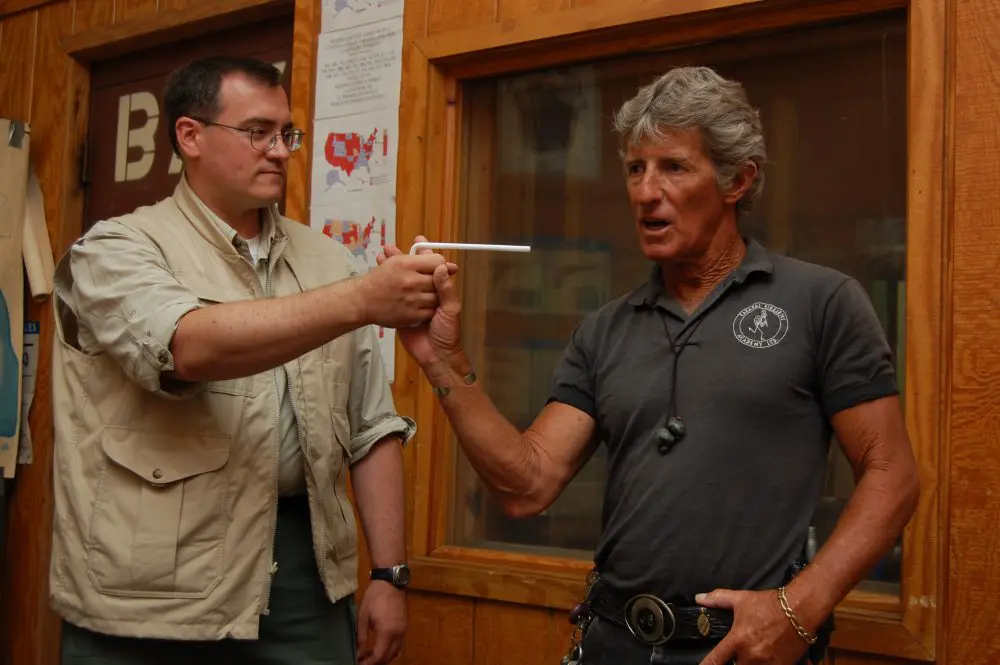YOU’RE burbling along on a dark country highway when the red and blue lights start flashing in your rear-view mirror. A quick flick of the eyeballs down to the speedometer confirms you’re abiding by the legally stipulated rate of knots, and you know you haven’t violated any traffic laws. Your seatbelt is secured, your vehicle is mechanically in compliance with the requirements of the law, and the only other living being you’ve seen in the past hour was a suicidal squirrel.
The big question now becomes: Do you pull over onto the shoulder of the road and stop? The obvious answer is yes, you’re obligated to stop when a law enforcement officer requires you to do so. But this is based on the assumption that the person operating the Christmas-tree lights actually is an officer of the law carrying out his duties.
But it’s dark, you’re in the middle of nowhere, there’s nobody else in sight, and the Hairs of Instinct are raised to full extension on the nape of your neck. And while you don’t want to be cited for a traffic or vehicular code violation, or jailed or shot for failing to accede to a legal request, your sixth sense is revving through the red line.
This situation raises a tremendous quandary. If you don’t pull over, you could be facing legal—and possibly physical—ramifications. But if you let yourself be placed in a deer-in-theheadlights situation by an impersonator, you could be robbed and stranded— at best. Worst-case scenario, you’re physically beaten, raped, and/ or killed.
Yes, impersonating a police officer is a criminal offense. But so are murder and rape—and prisons are filled to the brim with murderers and rapists. And just as nobody thought Ted Bundy “looked” like a serial killer, survivors of nefarious actions by law enforcement impersonators always report that “he looked like a real cop.”
Urban society has dulled the edge of our observational powers, which means many people mentally register anyone dressed in a uniform and a cereal-box badge as an officer of the law. And with the advent of technology, these items—whether fakes or genuine stolen articles—are easily obtained by the wannabe or criminally intent. Similarly, look-alike items such as spotlights and add-on “beanie” lights can be affixed to generic vehicles, at least sufficient to pass a cursory and/or unwary civilian inspection.
Crooks know every trick in the book—that’s how they make their living. And despite the humorous video clips of incompetent criminal nincompoops often shown on television, it might be as well to remember that the majority of heavy-duty criminals are never caught.
Just as the law enforcement community utilizes innocuous-looking unmarked vehicles, so do crooks use dubiously marked cars and pickup trucks to ply their trade on unwitting civilians. And people tend to be more observant than they used to be in some situations, but proportionately blinder in others.
Fear breeds a bastard child. Fear of terrorism, fear of illness, fear of bankruptcy lead to this bastard child materializing into a mental hybrid of paranoia and idiocy. One has only to drive on an interstate highway and see a caravan of vehicles slow down to ten miles per hour below the required speed limit when they spot a highway patrol vehicle, to realize how people become cowed by their own fears.
Similarly, in these days of doubt, many people think that every officer of the law is supposed to be an insta-cop, placed on this planet solely for their personal protection—and that is not a policeman’s job. This latter mindset can sometimes get you into a heap of trouble with a misguided sense of trust in someone you misidentified as an officer of the law.
So it’s back to your midnight cruise and the appearance of whirling multicolored lights bouncing off the rearview mirror. Because of automatic programming, you slow down and head toward the shoulder of the road. When your vision is blinded by a mirror- reflected spotlight, you’re figuring, “Okay, good tactics employed by a safety-conscious officer.”
And then that sixth sense creeps into your head. First, you’re in the middle of nowhere. Second, you haven’t violated any traffic laws, and third, your vehicle was in perfect operating order when you checked it at the gas station an hour ago.
So do you pull to the side of the road and hope it’s Officer Friendly trying to inform you that the suspension doohickey underneath your car is about to fall off? Or do you assume it’s the Red Light Bandit reincarnated, and proceed to the nearest populated area without stopping?
The bottom line is that, even though your decision will be dictated by specific circumstances, think through the possibilities in advance and not when a split-second decision is being forced down your throat. Check terrain, road conditions, local laws, and maybe even discuss the potential with local authorities before you leave.
This author has been around a long time and known many law enforcement personnel. Admittedly based on personal experience only, I cannot think of a single reasonable, self-respecting officer who would PIT you into a mountainside for not immediately stopping under all the above-mentioned circumstances. This is based on the assumption that you weren’t showing some form of criminal activity or trying to run from a known legal vehicle stop.
Either way, it’s a difficult decision to make. Dependant on circumstances, it boils down to whether at that specific moment in time you’d prefer to face a team of lawyers or a group of gravediggers.
Some people don’t—or can’t— differentiate one from the other….






